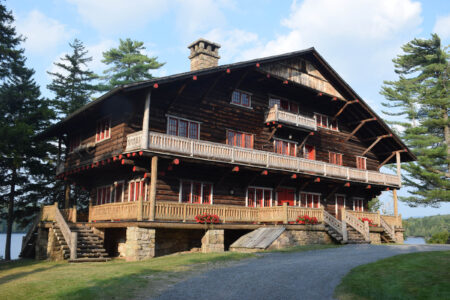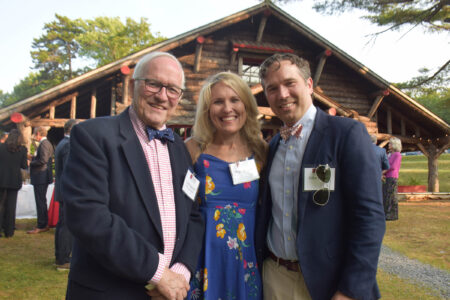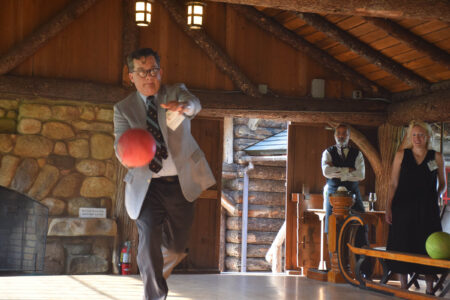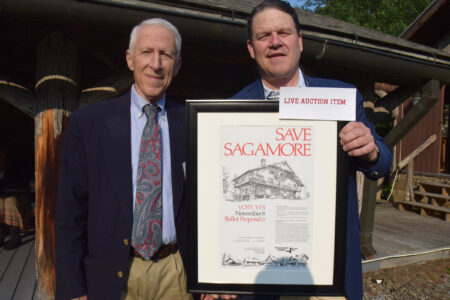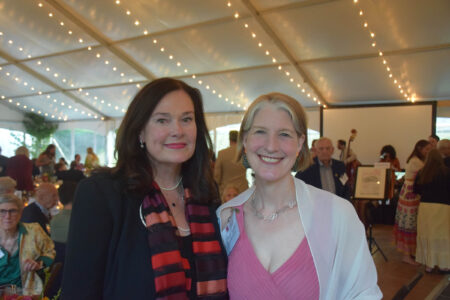Great Camp Sagamore celebrates 50 years of preservation
- Great Camp Sagamore is seen on Saturday. (Enterprise photo — Chris Gaige)
- Howie Kirschenbaum, left, and Barbara Glaser stand to be recognized at Great Camp Sagamore’s annual Gala and Benefit for Historic Preservation on Saturday. (Enterprise photo — Chris Gaige)
- From left, Clark Durant, Hope Loomis and John Durant smile with the Playhouse behind them at Great Camp Sagamore’s annual Gala and Benefit for Historic Preservation. (Enterprise photo — Chris Gaige)
- The Playhouse at Great Camp Sagamore is seen on Saturday. (Enterprise photo — Chris Gaige)
- Preservation League of New York State Board of Trustees Chair Patrick Ciccone bowls at Great Camp Sagamore’s annual Gala and Benefit for Historic Preservation — with 2025 marking the 50-year anniversary of the effort to preserve the property and its historical buildings. The camp includes an open-air historic pair of bowling lanes. (Enterprise photo — Chris Gaige)
- Howie Kirschenbaum, left, and Douglas Stinson smile with an original poster urging voters to approve Ballot Proposal 6, which amended the state constitution to allow for a land exchange whereupon nearby undeveloped lands of appraised at an equal value would be added to the forest preserve in exchange for the lands that Great Camp Sagamore’s Upper Complex sit on to be transferred out of the forest preserve to the nonprofit Sagamore Institute of the Adirondacks for preservation. Kirschenbaum, along with Barbara Glaser, led the effort to get the amendment passed through the state legislature and ultimately by voters, where it passed with more than 62.7% of the vote in the 1983 general election. (Enterprise photo — Chris Gaige)
- Great Camp Sagamore Board of Trustees Chair Kathleen Peartree Moon, left, and Executive Director Emily Martz smile at the annual Gala and Benefit for Historic Preservation — with 2025 marking the 50-year anniversary of the effort to preserve the property and its historical buildings. (Enterprise photo — Chris Gaige)
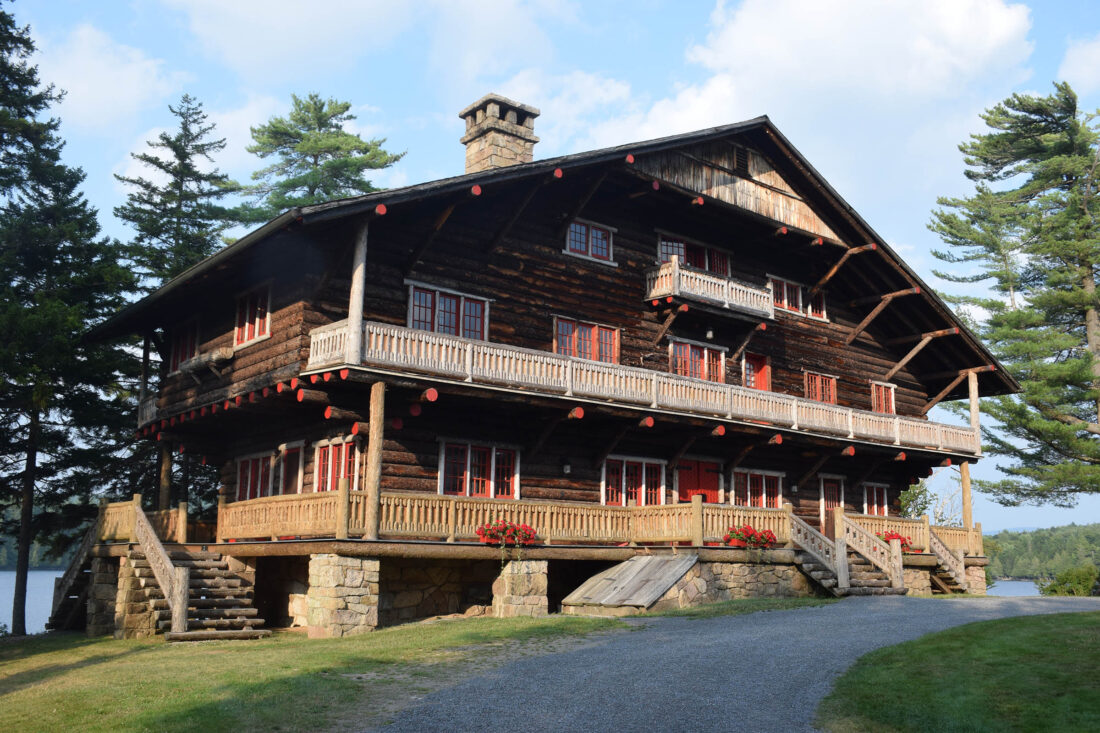
Great Camp Sagamore is seen on Saturday. (Enterprise photo — Chris Gaige)
RAQUETTE LAKE — Perched on the shores of Sagamore Lake and tucked deep into the woods four miles down a dirt road, Great Camp Sagamore’s rustic opulence in many ways defines the story of Adirondack preservation.
Its buildings sit eloquently between mowed lawns and gravel paths, hosting visitors over a robust summer of public tours and other special events put on by the Sagamore Institute of the Adirondacks, the nonprofit organization tasked with preserving the great camp and telling its story — from the 1890s through today.
On Saturday, Sagamore’s annual Gala and Benefit for Historical Preservation was held, with this year taking on added significance as 2025 marks the 50th anniversary of when the camp was acquired by the Sagamore Institute of the Adirondacks, a nonprofit preservationist organization that operates the property today.
There were around 200 guests, including past board and staff members. The evening featured a silent auction, cocktails, dinner and remarks from staff and board members. Executive Director Emily Martz noted that visitations to Sagamore was up 17% this year, on the heels of a 20% increase last year.
“We’re here because of those who came before,” she said. “Fifty years ago, a small group of people had the vision … passion and the persistence to save this place.”
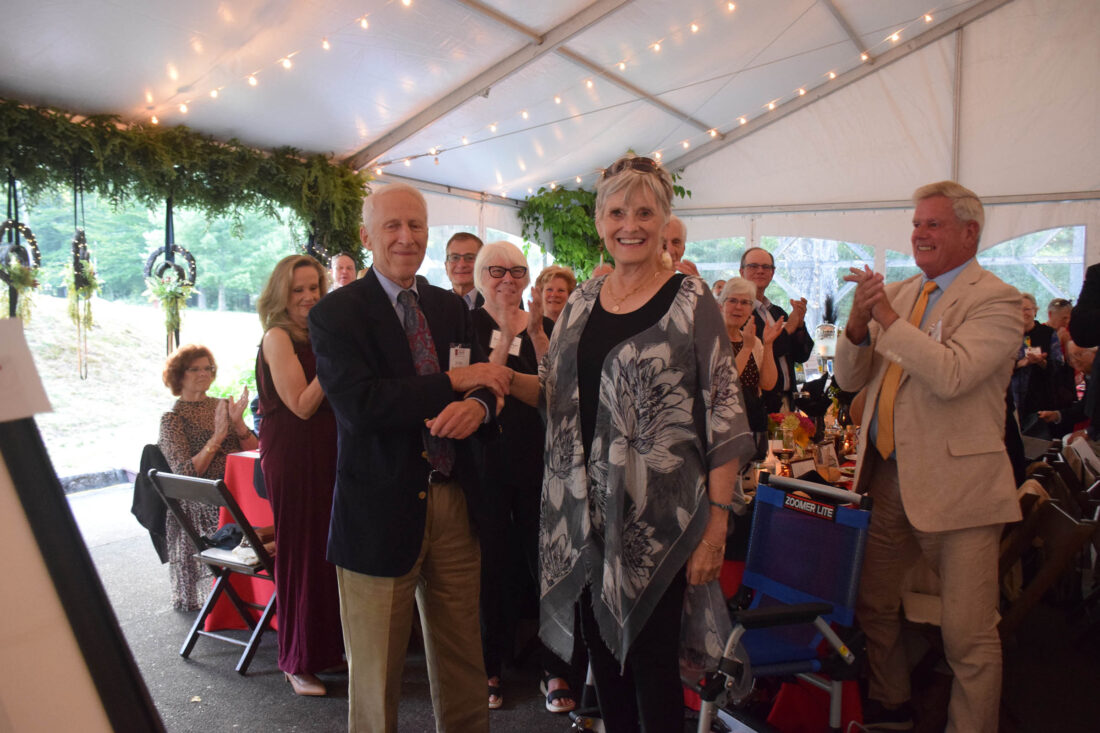
Howie Kirschenbaum, left, and Barbara Glaser stand to be recognized at Great Camp Sagamore’s annual Gala and Benefit for Historic Preservation on Saturday. (Enterprise photo — Chris Gaige)
Great Camp Sagamore’s saga goes back to the 1890s. It was originally constructed from 1895 to 1987 by William West Durant, who was the son of railroad magnate Thomas C. Durant. William West Durant pioneered the Adirondack Great Camp style, designing and building several others, such as Uncas and Pine Knot. Several generations of Durant’s descendants were in attendance at the gala.
Durant built Sagamore — not to be confused with the Sagamore Resort in Lake George — as a private family camp, though struggling family finances forced him to sell it shortly after it was built. It was bought in 1901 by Alfred Gwynne Vanderbilt Sr., the great-grandson of Cornelius Vanderbilt, nicknamed “the Commodore,” for the vast railroads and shipping businesses he built in the 1800s.
The camp remained with Alfred until his death aboard the RMS Lusitania in 1915, at which point it was passed to his second wife, Margaret Emerson McKim, who continued to entertain at the camp until she gifted it to Syracuse University in 1954, which then used it as a conference center.
Fifty years ago, Sagamore’s story was very much in jeopardy. In 1975, the great camp and its adjoining buildings had faced two decades of deferred maintenance. Staring down the stagflation crisis that gripped the nation in the 1970s, the university could no longer afford its already limited maintenance of the historic Adirondack Great Camp.
Looking to divest and focus on its more core educational aspects, New York state offered to buy the land. Much of what surrounded the 1,500-acre property was already state forest preserve. This presented an issue.
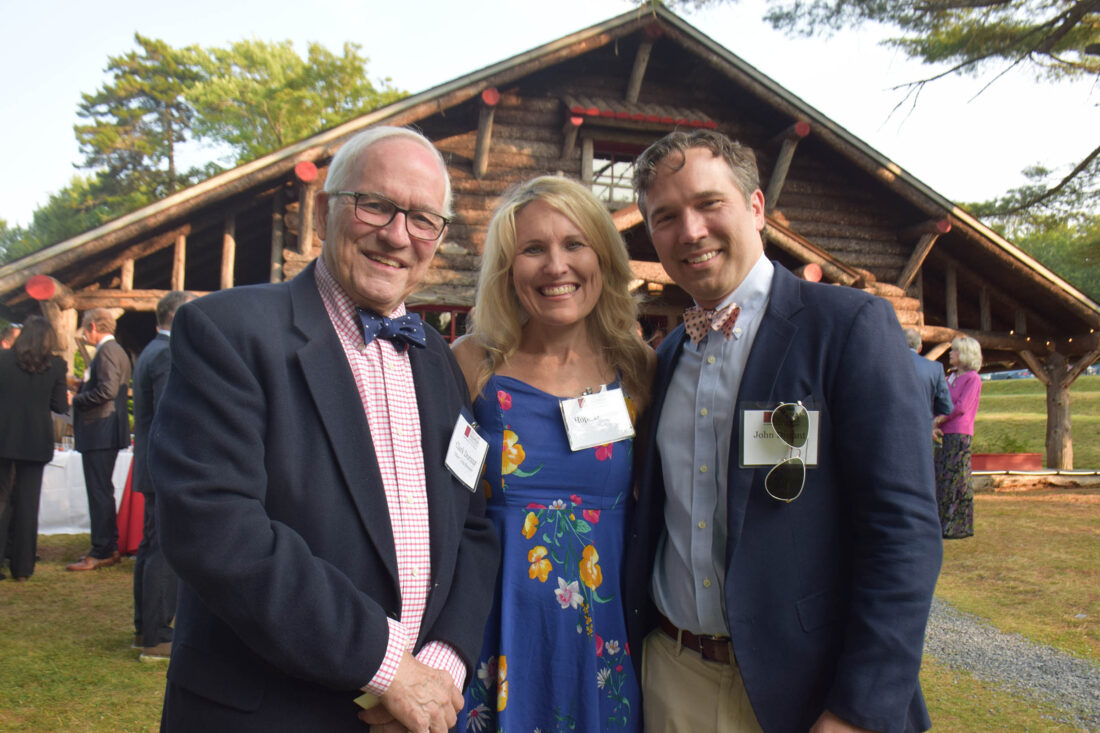
From left, Clark Durant, Hope Loomis and John Durant smile with the Playhouse behind them at Great Camp Sagamore’s annual Gala and Benefit for Historic Preservation. (Enterprise photo — Chris Gaige)
Under its Article 14 ‘Forever Wild’ provision, the state constitution required that any buildings on land to be entered into the forest preserve would have to be destroyed, in keeping with the land’s wild purpose. The nonprofit Preservation League of New York State had just formed in 1974. Despite its fledgling status then, the league began an intensive lobbying effort with state officials to save Camp Sagamore from destruction, given its architectural and cultural significance to the Adirondacks.
A complex deal was worked out where the state acquired the vast majority of the roughly 1,500-acre parcel for forest preserve, while agreeing to give the 7 acres that the main camp and some of its surrounding buildings sit on to the preservation league with several deed restrictions. These ensured that the site would be preserved and maintained in a way that would benefit the public and in character with the surrounding wild lands.
After the acquisition, the preservation league then bid the site to a smaller nonprofit — in accordance with the deed restrictions and mission — that would focus exclusively on preserving it. The Sagamore Institute of the Adirondacks secured the bid for $100,000.
That group was run then by two preservationists who had been living in Upper Jay, Barbara Glaser and Howie Kirschenbaum. They were 25 and 31, respectively, when they first took over the sprawling site.
“We were really young, and that was a good thing, because we had no idea the amount of work it was going to take to make this happen,” Glaser said. “The thing I’m so proud of is that we’ve kept this place alive. It’s become a national historic landmark. Its program this summer is totally full. It’s a vital part of the economy of the central Adirondacks in a way that thrives on the preservation of the resource, not the destruction of the resource.”
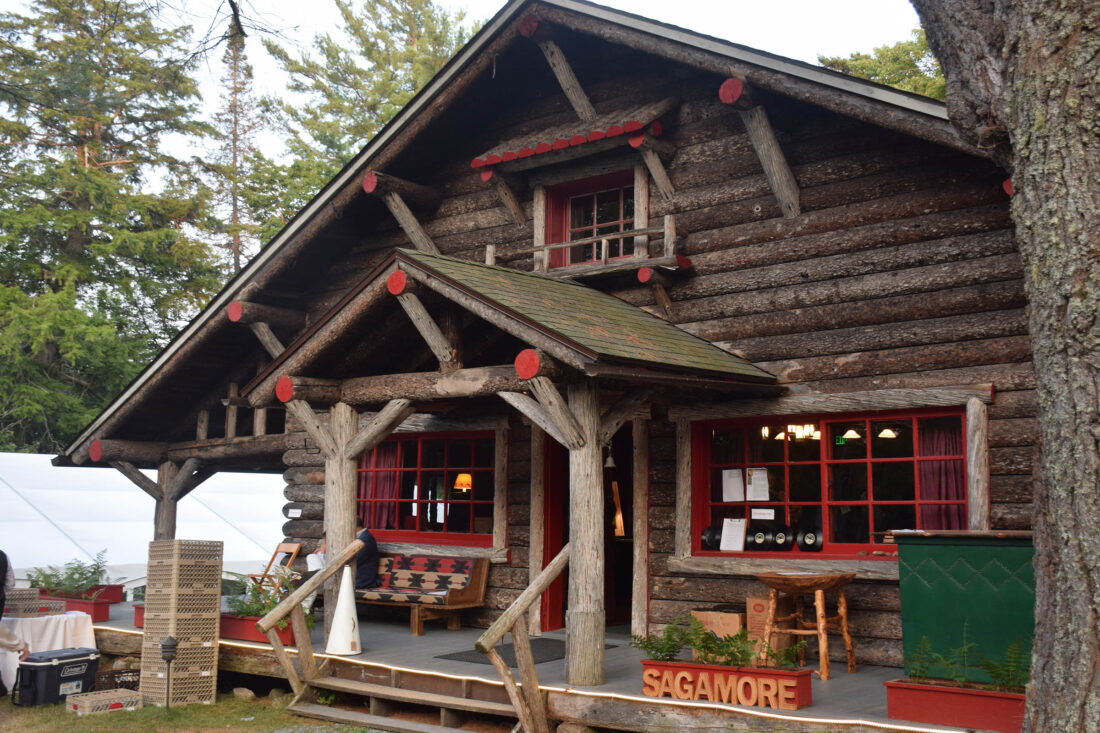
The Playhouse at Great Camp Sagamore is seen on Saturday. (Enterprise photo — Chris Gaige)
The two received a thunderous round of applause and a standing ovation at the gala as they were recognized for their herculean and odds-defying efforts to spearhead Sagamore’s preservation, turning it from disrepair to the gold standard of Adirondack preservation today.
Among Glaser and Kirschenbaum’s first major challenges was “reuniting” Great Camp Sagamore to its complete original set of structures. That’s because during the original land transfer, the property’s “Upper Complex,” consisting of the worker and service buildings, was left out, while the “Lower Complex,” where the main lodge and some of the immediate surrounding buildings were set aside for preservation.
There was a similar concern: that the buildings would be torn down in keeping with the ‘Forever Wild’ clause. The preservation groups once again rallied state lawmakers to save Sagamore, this time through a constitutional amendment that allowed for a land exchange, with the state giving the land that contained the Upper Complex to the Sagamore Institute of the Adirondacks for preservation while the non-profit gave 240 acres of nearby undeveloped land to the state to add to the forest preserve.
It wasn’t an easy initiative. In order to receive ballot access, the groups had to get the ammendment’s text passed by both chambers of the state legislature in two consecutive terms. Once that hurdle was overcome, the preservationists embarked on an expansive campaign to educate voters across the state about the cause and convince them that it was worthy of amending the state constitution to protect.
Ultimately, their efforts paid off. In 1983, the amendment was passed by voters resoundingly, securing 62.7% statewide.
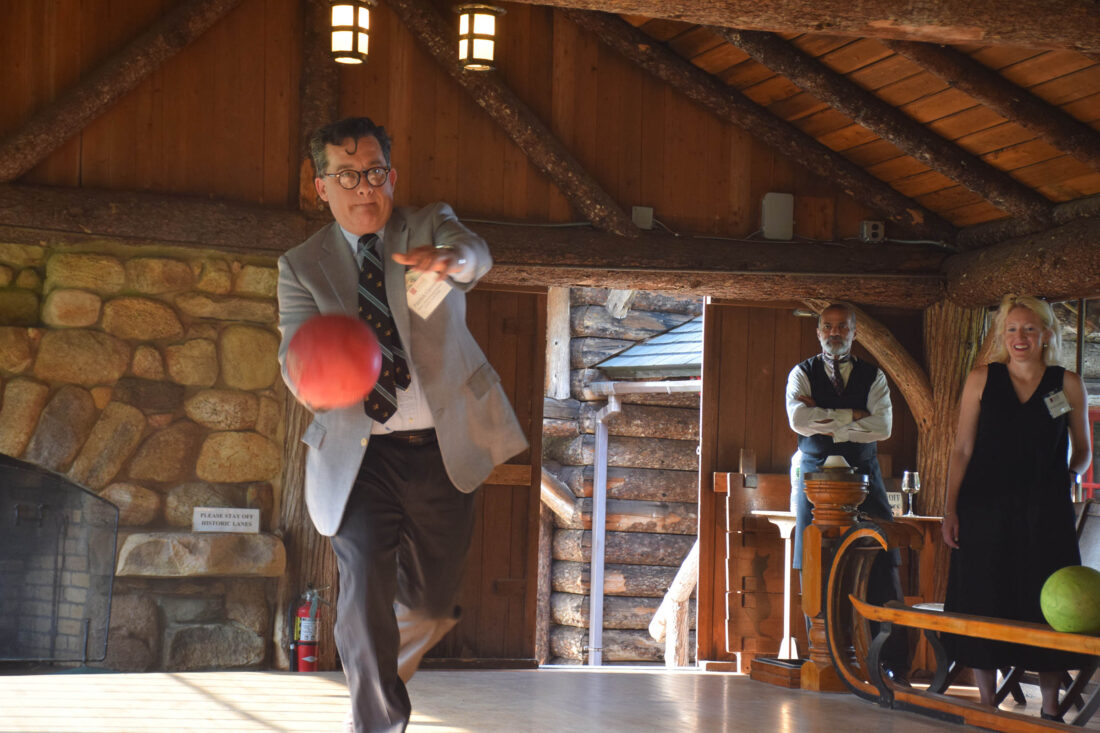
Preservation League of New York State Board of Trustees Chair Patrick Ciccone bowls at Great Camp Sagamore’s annual Gala and Benefit for Historic Preservation — with 2025 marking the 50-year anniversary of the effort to preserve the property and its historical buildings. The camp includes an open-air historic pair of bowling lanes. (Enterprise photo — Chris Gaige)
Securing a constitutional safeguard, while among the most high-profile of the efforts, is just the tip of the spear when it comes to maintaining a property as old and isolated as Sagamore. Glaser said that the property, as it’s experienced today, would simply not be possible without donors, staff and a dedicated cadre of volunteers, who, among a host of activities, have working weekends to open and close the camp at the beginning and end of its summer season.
Great Camp Sagamore Historian Connor Williams credited much of what the site has transformed into today to Glaser and Kirschenbaum’s vision to see Great Camp Sagamore as something that could be much more than when they first took over, noting that they realized that merely using the space as a conference center left so much unrealized public benefit.
“They realized, ‘We have this really exceptional property — full of history, full of nature, full of opportunity,'” he said. “‘It’s going to take a lot of work to preserve it, but if we do, we can morph from being a conference center to being an exceptional, unique, one-of-a-kind experience — either in the Adirondacks or the whole world.'”
Williams said it was incredible to see the story’s trajectory over 50 years, from a small intrepid crew aiming to restore and grow Sagamore’s presence in the face of uncertainty, into a National Historic Landmark that tells the rich history of the camp — both in the context of the humans who used and preserved it, and the wilderness that surrounds it — to an ever-growing audience.
“I think that (Saturday’s) turnout and exceptional support really was evidence that dreams, and especially historic dreams, can be realized,” he said. “That 50 years ago, a few young, energetic educators saw that a property that had been used exclusively as a vacation manner, and then later as a conference center, could become something far more unique than either. … They saw an exceptional opportunity to blend history, nature and community into a nonprofit organization where people could reflect on the present and prepare for the future while being surrounded by the past.”
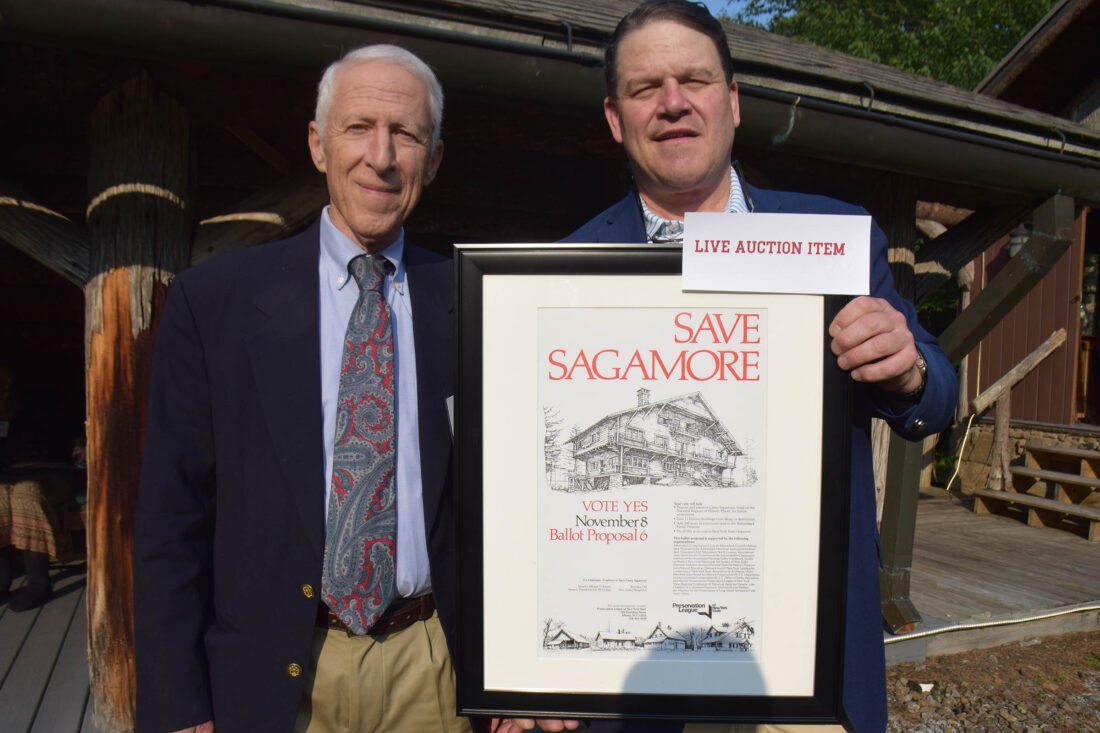
Howie Kirschenbaum, left, and Douglas Stinson smile with an original poster urging voters to approve Ballot Proposal 6, which amended the state constitution to allow for a land exchange whereupon nearby undeveloped lands of appraised at an equal value would be added to the forest preserve in exchange for the lands that Great Camp Sagamore’s Upper Complex sit on to be transferred out of the forest preserve to the nonprofit Sagamore Institute of the Adirondacks for preservation. Kirschenbaum, along with Barbara Glaser, led the effort to get the amendment passed through the state legislature and ultimately by voters, where it passed with more than 62.7% of the vote in the 1983 general election. (Enterprise photo — Chris Gaige)
More information on Great Camp Sagamore can be found at sagamore.org.
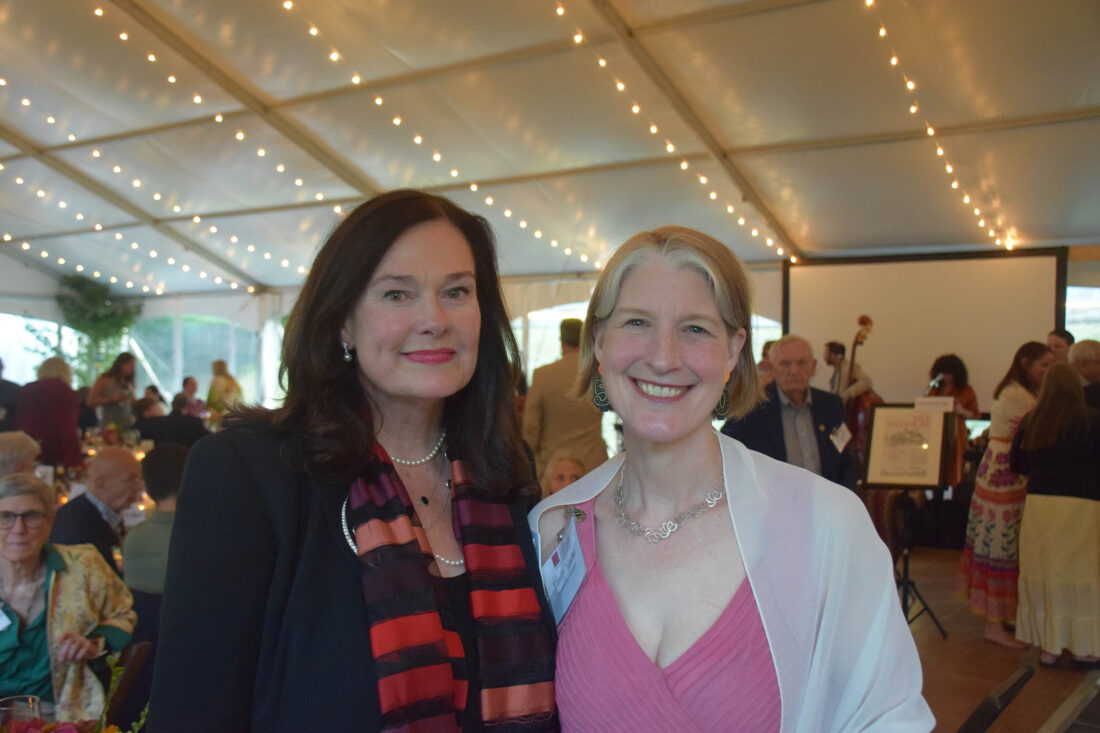
Great Camp Sagamore Board of Trustees Chair Kathleen Peartree Moon, left, and Executive Director Emily Martz smile at the annual Gala and Benefit for Historic Preservation — with 2025 marking the 50-year anniversary of the effort to preserve the property and its historical buildings. (Enterprise photo — Chris Gaige)

